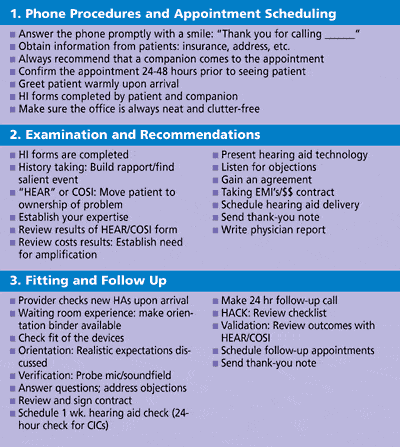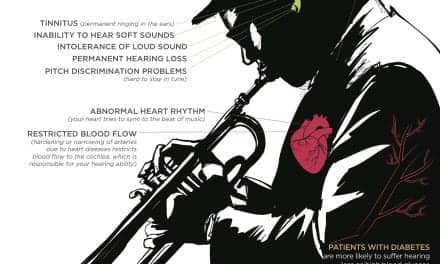Part 1 of this article took the position that, if hearing care professionals truly want to be leaders and reach those people who need audiological products and services, then we must change ourselves; we cannot expect our patients to do the changing or the technology we dispense to suddenly solve the communication problems of our patients. Part 2 examines five specific areas that can be changed in many practices/businesses.
As hearing care professionals, we are asked to understand the most technical aspects of the auditory system, signal processing, and instrumentation. We are not asked to understand the most important aspect of our profession: the human being who needs our help and does not know how to open themselves to our assistance. This often-overlooked aspect of our profession demands curiosity, courage, and a great willingness to risk the comfort of our daily clinical routine. Part 1 of this series was a call to action: We addressed what needs changing. We asked hearing professionals to think outside the box and examine both their technical and interpersonal skills as well as their clinical processes. Part 2 will focus on exactly how some aspects can be change in a positive way.
Since its inception in 1998, over 600 hearing professionals from across the US and Canada have participated in the Sonus Greenhouse program to learn more about clinical audiology, business development, and service delivery. What follows are five effective solutions for change. These solutions for change have been field-tested by Sonus Greenhouse graduates and can be applied tomorrow morning in your clinic.
1. Start with a script. At the initial encounter with the patient, it is vital for the hearing care professional to build rapport and trust by opening the patient with a series of open-ended questions. Incorporating a script into your case history is an effective way to stay on track as you “open” the patient with questions and allow them to establish ownership of their communication difficulties.
You may think that a standard case history is a script of sorts. It is not. All too often using only a case history leads to a guessing game that prohibits the reluctant patient from expressing their point of view. If the patient already had the information that allowed them to effectively cope with the hearing problem, they would not be reluctant or in denial. It is imperative that you realize the reluctant hearing-impaired patient is “unavailable” to the emotional component of their impairment. They’re carrying emotional baggage, and it is safest for them to blame external causes for their communication difficulties.
Yet, they have come into your clinic. This action is monumental. The goal is to help the patient gain insight, and help the patient reveal themselves and their hearing problem to themselves. It is not our language that will help the patient; it is the answers to our counseling questions that will break the emotional stalemate he/she is wrestling with. Here are examples of scripted questions used during the case history.
- “Mr. ____, who encouraged you to come see me today?”
- “What sort of things has your wife been saying about the level of communication between the two of you?”
- “How long have you been aware of this communication issue with your wife?”
- “Does this breakdown in communication between you and your wife concern you?”
- “Given your concern, would it be fair to say that you are not only here for your wife, but you are also here for yourself?”
- “You mentioned that you have been aware of these communication difficulties for ___ years. Do I have that right? However, you did not come in here ___ years ago, or even ___ months ago. What is it about NOW that brought you in?”
Start with a script, then use “empty-headed listening” and allow the patient to elaborate. (Author’s Note: The term “empty-headed listening” is attributed to Dr. Carl Rogers. The term refers to the ideal, uncluttered, truly receiving state of mind a health care clinician needs to have in order to effectively listen to the client. For a good overview of the work of Carl Rogers, the authors recommend The Carl Rogers Reader.1) Allowing the patient to articulate their feelings about their communication difficulties requires excellent listening skills.
As mentioned in Part 1 of this article, excellent listening skills require curiosity and authenticity.22 An excellent summary of this approach appears in a recent article2 by audiologist Kris English:
Scores of workshops and books on “active listening” teach you what you should DO to be a good listener. Their advice is relatively similar—ask questions, paraphrase, acknowledge the patient’s view, sit attentively and look them in the eye—-all good advice. You emerge from these courses eager to try out new skills, only to become discouraged when your friends or colleagues complain that you sound phony or mechanical. “Don’t try that active listening stuff on me,” they say. The problem is this: you were taught what to say and how to sit, but the heart of good listening is authenticity…Authenticity means that you are listening because you are curious and because you care, not because you are supposed to. The real issue is this: Are you curious? Do you genuinely care? If you think you already understand how someone else feels or what they are trying to say, it is a delusion…There is more to learn about that person sitting in front of you.2
These essential traits will enable the clinician to deviate from the script and focus deeply on the individual’s unique listening needs. Capture this dialogue by using the COSI.3 Then summarize with the following questions:
- “What other environments do you find the level of communication to be less than you would like it to be?”
- “If I could help you communicate better in (list situations nominated on the COSI), would that be the result you are looking for?”
A caveat about using scripts: The script is the foundation, but the hearing professional provides the soul. It’s important to tailor your script to your personality. Reading the words of any script verbatim off your case history form sounds insincere. Craft the script to your style without losing it’s powerful content. Also, remember to allow for silence. People need time to reflect when they answer open-ended questions. After you ask the patient a question off your script, give them a few moments to reflect and answer before moving onto the next question. Don’t bow to the desire of trying to fill silence with your own thoughts and words. Silence will help build rapport and trust.
2. Manage the clinical process with a series of “next steps.” The patient’s experience can be broken down into three phases (Figure 1). Phase I is the experience the patient has scheduling an appointment to see you and his/her experience in the waiting room. Phase II is made up of the initial case history, completing a needs assessment, examination, and hearing the professional’s recommendations. Phase III is the hearing aid fitting and all follow-up completed thereafter. Within each of these three phases, there are several smaller steps.

Figure 1. One of the crucial elements in producing customer
satisfaction is following a defined protocol in which each step
is viewed as integral. Consistently, process has been shown to
be more important than skill/talent relative to producing
satisfied customers.
In order to truly meet the needs of your patients and maintain an efficient and profitable business, it is critical to follow each of these steps with every patient. Although this task appears mundane, the methodical application of a step-by-step process has been proven to be successful in building value in the eyes of the patient.4 Consistently following a clinical process—and not skipping any steps—with every patient also minimizes the possibility of the “surprise attack” at the end of the appointment when the patient, who is ready to accept your recommendation of new hearing aids, says he/she “has to think about it some more” before making a decision.
3. Focus on selling the “experience of improved communication” rather than just a product (hearing aids). In any service encounter, perception is reality. In other words, the value the patient places on your product and services is determined by how the patient feels about you and your office.5 The Service Profit Chain6 suggests that a customer’s perceived value is largely determined by both the quality of the product and the quality of your process. The patient may be walking out your door with a pair of expensive hearing aids, but much of the money they paid you is for the “experience of improved communication.”
This experience goes far beyond the devices they have purchased. The length of time a patient waits to see you, the way you resolve objections to price, the service “rituals” you provide, and other small, seemingly insignificant details do not go unnoticed by the patient.
The entire service experience needs to be congruent. Every aspect of your encounter with the patient needs to be consistent and match your standard of care. If you want to have an impeccably professional image with the public, every detail in your appearance and your office’s appearance needs to reflect this overriding philosophy. Leave out one small detail and it may get noticed, and the perceived value of the experience you are providing patients will be negatively affected. If you focus on providing your patients with the “experience of better hearing” and not just “selling” them a product, you must account for the details that enhance your value and building of long-term relationships.
4. Manage yourself like a business and measure your progress. In order for your business to survive it must be profitable. In most hearing aid dispensing businesses, the professional is the business.
Every successful business has one common denominator: They know their numbers. Profitability requires detailed information. Cost of goods, average retail cost of products/services delivered, cash flow, and return-for-credit rate, among other operational variables, needs to be tracked on a monthly basis. In addition, all marketing campaigns should be tracked in order to monitor their cost-effectiveness.
The focus of any service-oriented business should be serving the customer. Customer loyalty and employee loyalty are two essential elements of this.6 Measuring what customers and employees think about your business by using satisfaction surveys will help you identify areas in your business requiring improvement.
5. Practice your techniques and be willing to adopt new approaches. Many of us learned long ago that in order to get better at something you have to study, practice new techniques, and gain experience. Counseling, technical expertise, and interpersonal ability are all skills requiring practice. For the busy hearing care professional, this means keeping up with the professional research and published literature, as well as surfing the Internet on occasion.
However, there are times when this is not enough. Sometimes, if you truly want to be outstanding at something, it requires that you adapt a fresh approach to something you are doing. Adding probe microphone measurements to your fitting process, rethinking the way you take earmold impressions, doing speech-in-noise testing, and adding some outcome measures to your protocol are just a few of the possibilities. Part of the Sonus Greenhouse experience is a role-playing exercise whereby each attendee plays the role of the hearing professional whose job is to guide the reluctant patient through the process of taking ownership of the communication difficulty and working towards an agreed upon solution.
If we want the hearing care profession to evolve, all of us need to embrace curiosity, take the risk, and dedicate ourselves to positive change.


|
Correspondence can be addressed to Brian Taylor, Sonus Corp, 111 SW Fifth Ave., Ste. 1620, Portland, OR 97204; email: [email protected].
References
1. Rogers C. In: Kirschenbaum H, Land Henderson V, eds., The Carl Rogers Reader. New York: Houghton-Mifflin, 1989.
2. English K. Are we really helping people hear better? Audiol Today. 2002;14(2):11.
3. Dillon H, James A, Ginis J. Client Oriented Scale of Improvement (COSI) and its relationship to several other measures of benefit and satisfaction provided by hearing aids. J Amer Acad Audiol. 1997; 8:27-43.
4. Barker J. Next-Step Selling: A New Sales Approach to Create and Deliver Value For Your Customers. Australia: Prentice Hall, 2001.
5. Chase R, Sririam D. Want to perfect your company’s service? Use behavioral science. Harvard Business Review. June 2001; 5:78-85.
6. Heskett J, Sasser WE, Schlesinger LA. The Service Profit Chain: How Leading Companies Link Profit and Growth to Loyalty, Satisfaction and Value. New York: The Free Press, 1997.




